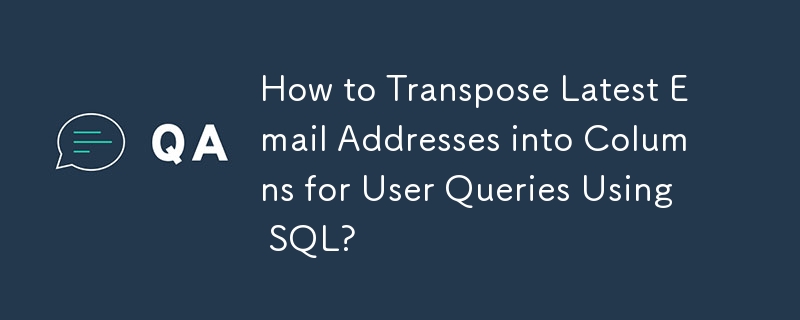 Database
Database
 Mysql Tutorial
Mysql Tutorial
 How to Transpose Latest Email Addresses into Columns for User Queries Using SQL?
How to Transpose Latest Email Addresses into Columns for User Queries Using SQL?
How to Transpose Latest Email Addresses into Columns for User Queries Using SQL?
Jan 10, 2025 pm 04:16 PM
Transpose latest email address into column for user query
In database management, it is often necessary to convert data from its initial form into a format that facilitates efficient analysis and retrieval. One of these transformations involves transposing rows of multiple email addresses associated with a user into columns. This allows extracting the latest available email address for each user based on specific criteria (such as creation date).
To achieve this conversion, you can use the tablefunc function in the crosstab() module. The following SQL query demonstrates how to use crosstab() to transpose the last three email addresses of each user:
SELECT * FROM crosstab(
$$SELECT user_id, user_name, rn, email_address
FROM (
SELECT u.user_id, u.user_name, e.email_address
, row_number() OVER (PARTITION BY u.user_id
ORDER BY e.creation_date DESC NULLS LAST) AS rn
FROM usr u
LEFT JOIN email_tbl e USING (user_id)
) sub
WHERE rn < 4
ORDER BY user_id
$$
, 'VALUES (1),(2),(3)'
) AS t (user_id int, user_name text, email1 text, email2 text, email3 text);In this query, the subquery calculates the row number for each email address, separated by user_id, and sorted in descending order based on creation_date. The NULLS LAST clause ensures that null values are treated as the lowest ranked value. The generated rn line numbers are then used to limit each user's selection to the first three email addresses.
crosstab() function takes two parameters: the query string (defining the data source) and the key value to be used as the column transpose. In this example, the query string retrieves relevant data from the usr and email_tbl tables, and the second parameter specifies the value (1),(2),(3), corresponding to the three columns email1, email2, and email3.
query is a table containing user_id, user_name, and the three most recent email addresses for each user, transposed into separate columns. This transformation simplifies the retrieval of each user's latest available email address, allowing for efficient data analysis and communication.
The above is the detailed content of How to Transpose Latest Email Addresses into Columns for User Queries Using SQL?. For more information, please follow other related articles on the PHP Chinese website!

Hot Article

Hot tools Tags

Hot Article

Hot Article Tags

Notepad++7.3.1
Easy-to-use and free code editor

SublimeText3 Chinese version
Chinese version, very easy to use

Zend Studio 13.0.1
Powerful PHP integrated development environment

Dreamweaver CS6
Visual web development tools

SublimeText3 Mac version
God-level code editing software (SublimeText3)

Hot Topics
 Reduce the use of MySQL memory in Docker
Mar 04, 2025 pm 03:52 PM
Reduce the use of MySQL memory in Docker
Mar 04, 2025 pm 03:52 PM
Reduce the use of MySQL memory in Docker
 How do you alter a table in MySQL using the ALTER TABLE statement?
Mar 19, 2025 pm 03:51 PM
How do you alter a table in MySQL using the ALTER TABLE statement?
Mar 19, 2025 pm 03:51 PM
How do you alter a table in MySQL using the ALTER TABLE statement?
 How to solve the problem of mysql cannot open shared library
Mar 04, 2025 pm 04:01 PM
How to solve the problem of mysql cannot open shared library
Mar 04, 2025 pm 04:01 PM
How to solve the problem of mysql cannot open shared library
 What is SQLite? Comprehensive overview
Mar 04, 2025 pm 03:55 PM
What is SQLite? Comprehensive overview
Mar 04, 2025 pm 03:55 PM
What is SQLite? Comprehensive overview
 Run MySQl in Linux (with/without podman container with phpmyadmin)
Mar 04, 2025 pm 03:54 PM
Run MySQl in Linux (with/without podman container with phpmyadmin)
Mar 04, 2025 pm 03:54 PM
Run MySQl in Linux (with/without podman container with phpmyadmin)
 Running multiple MySQL versions on MacOS: A step-by-step guide
Mar 04, 2025 pm 03:49 PM
Running multiple MySQL versions on MacOS: A step-by-step guide
Mar 04, 2025 pm 03:49 PM
Running multiple MySQL versions on MacOS: A step-by-step guide
 What are some popular MySQL GUI tools (e.g., MySQL Workbench, phpMyAdmin)?
Mar 21, 2025 pm 06:28 PM
What are some popular MySQL GUI tools (e.g., MySQL Workbench, phpMyAdmin)?
Mar 21, 2025 pm 06:28 PM
What are some popular MySQL GUI tools (e.g., MySQL Workbench, phpMyAdmin)?
 How do I configure SSL/TLS encryption for MySQL connections?
Mar 18, 2025 pm 12:01 PM
How do I configure SSL/TLS encryption for MySQL connections?
Mar 18, 2025 pm 12:01 PM
How do I configure SSL/TLS encryption for MySQL connections?






